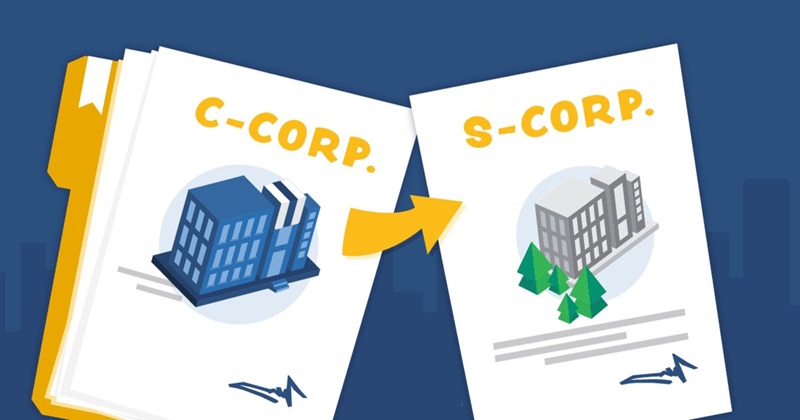Corp to Corp (C2C) implies that another business will pay an LLC or corporation for your services instead of paying a person. However, failing to understand what is corp to corp and many other drawbacks can increase your company’s employment taxes.
No worries. This blog post will clarify the definition of corp to corp, providing 3 insightful facts about this contractor type. Ultimately, whether a C2C, 1099, or W2 will be compared to help you understand corp to corp meaning. Scroll down now.

What Is Corp-to-Corp?
Having a corp-to-corp relationship with someone means paying an LLC or corporation for services instead of an individual worker. This arrangement implies your “corporation” will be providing a corporation’s services. Under a corp-to-corp agreement, the contract worker must have an LLC, C corporation, or S corporation.

The bottom line is that corp to corp meaning is that you must own an LLC and register as a C corporation or S corporation. For example, if Nike hires a shoe design consultant who owns Savvy Sneakers, LLC, Nike engages the worker under a corp-to-corp arrangement.
Benefits of C2C Contract
C2C contracts can be beneficial for both employers and Corp to Corp contractors. Why?
To Employers
Employers do not have to bear the costs of employee benefits, taxes, and other overheads related to employing full-time staff. Instead, these responsibilities fall on the corporation that is providing the services. This will help employers:
- Reducing employment taxes.
- Lowering employment risk (it’s more challenging to sue in a C2C relationship).
- Minimizing the chances that the employer might be audited for worker misclassification.
- Corp to Corp allows for controlling their work and schedule.
- Choose which clients they work with, when, and how they work. Generating a pay increase of 10 percent or more over W-2 salaries.
- Providing tax savings and preventing you from lawsuits and debts.
- Having your own business and can hire different workers to do the work.
- Stacking contracts and earning a living from home.

What C2C Must Be Aware About Contracts?
After knowing what is corp to corp, you must want to understand this kind of contract more deeply. Wait no more! Below are 2 in-depth facts that you need to know about C2C:
Legal Structure and Liability
C2C contracts often involve a legal agreement between two business entities, even if one or both are sole proprietorships or single-member LLCs. But if you think this structure can provide many legal protections, then you are wrong.
According to Cenkus Law, being a member of an LLC corporation or other limited liability entity will not protect you from every possible risk and liability out there.
Tax Implications
When operating under a C2C contract, taxes are not typically withheld by the client paying for services. This means the independent contractor is responsible for paying all relevant taxes, including income and self-employment taxes.
Contractors must be diligent in setting aside money for taxes and may need to make quarterly estimated tax payments to the IRS and state tax agencies.
Importance of a Written Contract
A detailed written contract is crucial in a C2C relationship. This document should outline the scope of work, payment terms, deadlines, confidentiality clauses, and any other conditions of the working relationship.
A solid contract can protect both parties and clarify expectations, reducing potential disputes.
C2C, 1099, W2: How To Differentiate
One more issue arose! Business owners and contractors often find distinguishing C2C, 1099, and W2 hard. But before diving into the detailed differences among these terms, let’s look at the table below.
| Aspect | W-2 Contractor | Corp to Corp (C2C) | 1099 Worker |
| Tax Obligations | Employer-part taxes, income withholding | Consultant full taxes, quarterly filings | Self-pay taxes, no withholding |
| Payment Structure | Bi-weekly, per-hour | Monthly, post-invoice (up to 60 days) | Varied, can be as long a 60 days |
| Employee Benefits | Health, 401(k), PTO, etc. | Custom benefits, retirement plan SEP IRA | Insurance optional, no standard benefits |
| Legal Liability | Employer liability | Contractor LLC/S-corp liability | Contractor liability, possible IRS action if miss classified |
C2C vs 1099

- Business Structure: C2C involves setting up a C or S-corp or LLC. In contrast, a 1099 worker operates without forming a separate corporation.
- Tax Filings: Corp-to-Corp contractor must pay quarterly tax filings through their Cor S-corp or LLC. On the other hand, 1099 workers handle their own taxes but are not bound by the quarterly filing requirement.
- Payment Process: In C2C, the contractor’s C or S-corp or LLC invoices the company, which may result up to 60 days proceeding for the first payment. Tax Rates: Tax rates for C2C contractors tend to be higher due to different FICA and Social Security calculations.
- Liability and Insurance: W2 might be given employee compensation( health care protection) and the employer is liable for any legal responsibility. In contrast, 1099 contractors often take out personal insurance policies to mitigate risks.
Benefits and Retirement Plans: C2C allows contractors to create customized benefits and retirement plans through their business entity. This customization is not available to 1099 workers.
C2C vs W2
- Business Structure: C2C requires forming a C, S-corp, or LLC. W-2 contractors work like full-time employees but don’t need a separate business entity.
- Tax Filings: C2C contractors handle their own quarterly taxes. W-2 contractors have taxes like federal, Social Security, or Medicare partially paid by their employer, with income tax deducted from their pay.
- Payment Process: C2C contractors bill via their S-corp or LLC, which may delay the first payment up to 60 days. W-2 contractors usually get paid bi-weekly by the employer.
- Tax Rate: C2C contractors often pay their own taxes due to different FICA and Social Security calculations. W-2 employers cover half of these taxes.
- Employee Benefits: W-2 contractors might get benefits like full-time employees, such as health insurance. C2C contractors arrange their benefits through their business.
- Liability and Insurance: C2C contractors’ liability and insurance fall under their LLC or S-corp. W-2 contractors have these aspects covered by their employer.
- Retirement and Perks: W-2 contractors often enjoy employer-provided perks like paid leave, health benefits, and 401(k) plans. C2C contractors tailor their retirement and benefits to their business structure.

Frequently Asked Questions
What Is The Meaning Of Corp To Corp?
Corp to Corp (C2C) implies that when an alternative to paying you, a person, you must own an LLC or corporation that another enterprise will pay for your services.
Is It Better To Be C2C Or W-2?
Not really! The best choice varies based on personal financial goals, career priorities, and risk tolerance. C2C often offers higher rates and flexibility but lacks employee benefits like healthcare and paid leave. W-2 employment provides more stability, benefits, and legal protections but may offer lower pay and less autonomy.
Is C2C the Same As 1099?
No. A C2C worker is an independent contractor who is incorporated. Businesses typically contract these workers to work on a project basis, much like 1099 workers. However, the key difference is that C2C workers have their own incorporated company.
What Are The Advantages Of Corp To Corp?
Employers favor corp-to-corp arrangements for three main reasons:
- Reducing employment taxes.
- Cutting employment dangers (it’s more challenging to sue in a C2C relationship).
- Minimizing the chances that the employer might be audited for worker misclassification.
As you can see, the answer to the question “what is corp to corp” is not as complicated as you imagine. Simply put, it is a business agreement between two companies, often called “corporations”. However, depending on your financial situation, you must choose between C2C, 1009, and W2 wisely.
If you still need help with a corp-to-corp relationship, feel free to reach ERA. Our team is there 24/7 to give your business immediate tailored recommendations.
Ms. Tracy has worked in human resource consulting for over 15 years. A driven entrepreneur focused on business expansion and people development. She previously worked as Country Manager for an international Australia firm that specializes in global workforce management, as well as several key roles as Business Growth Director and Executive Search Director for both large local firms to effectively drive their business growth. A strong emphasis is placed on aligning organizational priorities/objectives with business needs. She has a large network of local business leaders and a thorough understanding of the local market.








